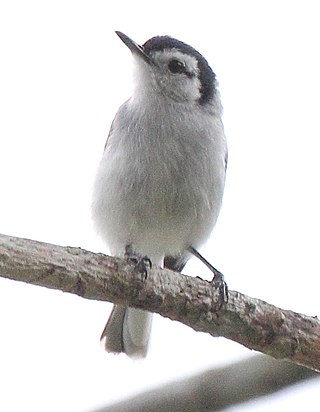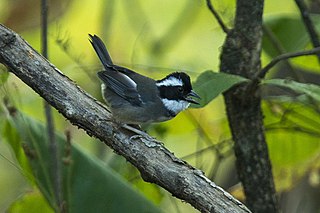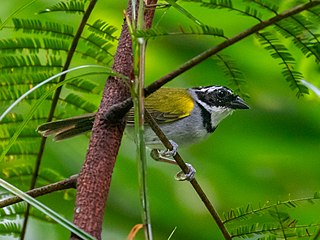
Jan Stanisław Sztolcman was a Polish zoologist, ornithologist and collector naturalist who travelled extensively in South America. He was also a promoter of conservation and worked to prevent the European bison from going extinct.

The tropical gnatcatcher is a small active insectivorous songbird, which is a resident species throughout a large part of northern South America. It was formerly considered as conspecific with the white-browed gnatcatcher and the Marañón gnatcatcher.

The black-and-white mannikin also black-and-white munia or red-backed mannikin, is a species of estrildid finch, widely occurring throughout the African tropical rainforest. It has an estimated global extent of occurrence of 4,200,000 km2. It is found in moist savanna and subtropical or tropical moist lowland forest habitat. The status of the species is evaluated as least concern. They are seedeaters, but are known to feed on algae.

The black-headed tailorbird, also known as the white-browed tailorbird, is a species of songbird in the cisticola family, Cisticolidae. First formally described by the Scottish ornithologist Arthur Hay in 1877, it is endemic to the southeastern Philippines, where it is found on the islands of Mindanao, Dinagat, and Siargao. It inhabits dense undergrowth in lowland forests at elevations of up to 1,000 m (3,300 ft). Black-headed tailorbirds show three distinct phenotypes, which correspond to different stages of maturity: adults have a 'black' phenotype, immature birds have a 'mottled' phenotype, and juveniles have a 'grey' phenotype. These phenotypes were previously incorrectly thought to be related to differences between the sexes or to represent different species.

The black-capped sparrow is a species of bird in the family Passerellidae.

Arremon is a genus of neotropical birds in the family Passerellidae. With the exception of the green-striped brushfinch which is endemic to Mexico, all species are found in South America, with a few reaching Central America.

The pectoral sparrow is a species of bird in the family Passerellidae. It is found in Bolivia, Brazil, Colombia, French Guiana, Guyana, Peru, Suriname, and Venezuela. Its natural habitat is subtropical or tropical moist lowland forests. The Brazilian name for this species is tico-tico-de-bico-preto, which in translation means "black billed sparrow".

The grey-hooded bush tanager is a species of South American bird in the tanager family Thraupidae. It is the only member of the genus Cnemoscopus. It is found in Bolivia, Colombia, Ecuador, Peru, and Venezuela. Its natural habitat is subtropical or tropical moist montane forests.

The yellow-browed antbird, or yellow-browed antwarbler, is a species of bird in subfamily Thamnophilinae of family Thamnophilidae, the "typical antbirds". It is found in Brazil, Colombia, Ecuador, and Peru.

The orange-crested flycatcher is a species of bird in the family Tyrannidae. It is found in Colombia, Ecuador, and Peru. Its natural habitat is subtropical or tropical moist montane forests.

Polioptila is a genus of small insectivorous birds in the family Polioptilidae. They are found in North and South America.

The hairy-crested antbird is a species of bird in subfamily Thamnophilinae of family Thamnophilidae, the "typical antbirds". It is found in Bolivia, Brazil, Colombia, Ecuador, and Peru.

The grey-throated babbler is a species of passerine bird in the Old World babbler family Timaliidae.

The black-backed bush tanager, also known as the black-backed bush-finch, is a species of bird in the family Thraupidae. It is the only member in the genus Urothraupis. It is found in Colombia and Ecuador. Its natural habitat is subtropical or tropical moist montane forests.
The Marañón gnatcatcher is a small active insectivorous songbird, that is found in the upper valleys of the Marañón River in northwest Peru. The species was formerly considered to be conspecific with the tropical gnatcatcher.

Tropidophis taczanowskyi, also known commonly as Taczanowski's dwarf boa, is a species of snake in the family Tropidophiidae. The species is native to northern South America.
The Rwenzori hill babbler is a species of passerine bird in the family Sylviidae that is found in Africa.

The black-capped paradise kingfisher or black-headed paradise kingfisher, is a bird in the tree kingfisher subfamily, Halcyoninae. It is native to several islands in the Bismarck Archipelago to the east of New Guinea. Like all paradise kingfishers, this bird has colourful plumage with a red bill and long distinctive tail streamers.

Microspingus is a genus of warbler-like birds in the tanager family Thraupidae. They are found in highland forest in South America.
The north Moluccan cicadabird is a passerine bird in the family Campephagidae that is found on the Bacan Islands, the Tukangbesi Islands and the island of Morotai in the northern Moluccas Islands of Indonesia. The species was formerly considered to be conspecific with the common cicadabird, now renamed the Sahul cicadabird.

















